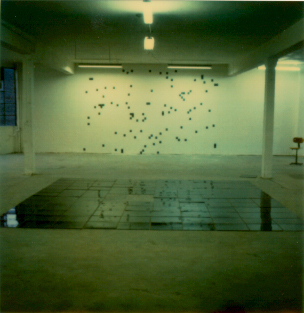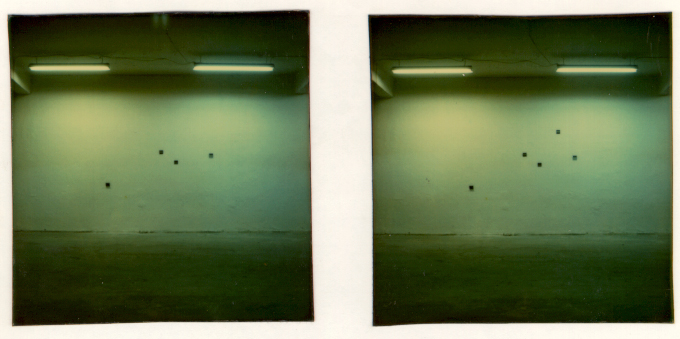|
Zoltán Szegedy-Maszák Three Early Works |
||
|
Following a number of exhibitions of paintings and installations during the late 1980s, I gradually developed a keen interest in technological images during the early 1990s.
For Sub Voce, the first large-scale Hungarian exhibition of video art in 1991, I made a large-size painting on the wall of the Budapest Kunsthalle, in the form of a performance for the opening of the show. There I utilised one of the drawbacks of analogue video technology, i.e., its tendency to degrade in quality every time the tapes were copied. |
||
 SUB VOCE, performance, 1991 |
The starting-point of the performance was a few dozen scribbles in felt-tip pen that I had recorded on a VHS video camera, and then copied the tapes repeatedly until I got a faded, blurred, and vibrating footage. Borrowing the method from my painter friends, who often used slide projectors to enlarge their drafts or redraw photographs, I projected this approximately twenty-minute video footage onto the wall of the exhibition space. With a thick paint-brush and black ink, I tried to depict the lines as they emerged on the wall. Independent of their original situation, however, the lines kept appearing in a horizontal stripe, confined to the middle of the frame or close to the centre. The phenomenon in question owns its existence to the shortcomings of analogue video technology, namely, the usage of a synchronizing signal marking the margins of “half-frames” (more precisely, the margins of the interlaced even and odd fields). With each copying, this mark becomes weaker and weaker, or at times disappears altogether. Consequently, the image details are vertically “floating” across the screen, but before they would find their place, the apparatus is already busy with flashing the upcoming “half image”. Thus, the interlaced scans result in a moving image with only a horizontal band carrying something of the recorded material, as demonstrated by the twenty-minute act of painting on the wall.
|
|
|
|
|
|
Oscillation, another installation from the same year, was also based on digital feedback, but it involved the excitation of an analogous system by utilising the specific characteristics of a toy computer from the 1980s. Three audiovisual programs were shown on three different TV sets, each four hours long. The hidden visual memory of the computer was used as the chaotic attractor that meant to generate random numbers. Manifesting again a fractal-like behaviour, simple concentric circles, complete with sounds corresponding to their positions and dimensions, displayed the mingling and oscillation of audiovisual information spreading from different sources/locations – a process dictated by simple algorithms, yet excitingly manifold.
The basic ideas behind these three early works pertained to picture noise, i.e., error as a picture generating element, the analogue and digital feedback, and the algorithms interpreting or generating digital images and imaging data. These have remained as integral elements in my work as a visual artist. | |
 OSCILLATION, computer installation (details), 1991 |

 OSTMODERN, installation using polaroid images (5th and 6th photo pixels from the wall), 1991
OSTMODERN, installation using polaroid images (5th and 6th photo pixels from the wall), 1991